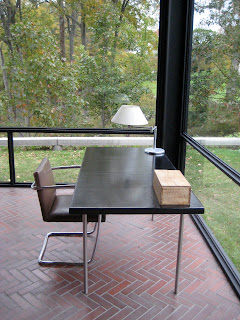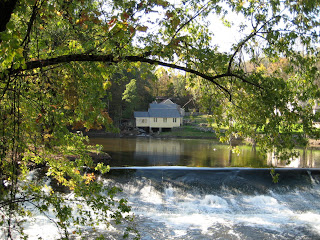Stillspotting NYC, an interdisciplinary project curated by the Guggenheim Museum, explores ways of finding quiet in the cacophony of senses that is urban living, especially in New York. Partnering with architects, artists, designers, composers and philosophers, assistant curator David van der Leer (from the museum's Architecture and Urban Studies program) and project associate Sarah Malaika steer the two-year project through its various incarnations in all of the city's five boroughs.
 |
| The sign to the will-call gallery at Castle Clinton, just paces from our first stop. |
"To a Great City," the aptly titled second edition of Stillspotting NYC, in time for the tenth anniversary of the September 11 attacks (the first was in June, with artist
Pedro Reyes installing in Brooklyn) features a partnership with architecture firm Snøhetta and the Estonian composer Arvo Pärt. Five sites, mostly in lower Manhattan and outdoors, were chosen, each featuring recorded works of Pärt's. Snøhetta subtly altered indoor and outdoors spaces, to quote the accompanying literature, "that embody the concept of a central musical tone and extend the perception of sound into the realm of space. . . . The staging . . . gradually transports visitors from the hustle and bustle of the streetscape to an elevated urban experience that makes them newly aware of the sense of hearing." Over the course of two weekends (it ends on September 25), this latest incarnation of the project promised to be moving, but I wasn't prepared for how deeply I would be touched.
 |
| Castle Clinton |
On a cool, crisp Sunday, a week after the somber 9/11 anniversary, my friend N. and I arrived at
Castle Clinton, the restored fort at the southern tip of Manhattan. How could we be transported from the insanity of the city without actually leaving it? We followed the suggested order (the sites can be visited in any order and at any time between 11am and 7pm) and entered Stillspot A.
From the first, tentative steps into Labyrinth at the Battery (just west of Castle Clinton) through a short journey to Governors Island and back to Manhattan and the World Trade Center, emotion ruled. I had traveled to Battery Park by bus from uptown Manhattan to take in the urban morning expecting nothing more than to listen to the music of a composer I'd admired for years. There was so much more.
For New Yorkers (and Washingtonians and Pennsylvanians), the wounds of September 11 remain remarkably fresh, even as the ache of loss dulls. My best friend pointed out recently that the reliving of the attacks by the media and the constant streams of visitors who have turned the World Trade Center into a tourist destination represent a constant "retraumatization" for those of us who witnessed the attacks and carry the knowledge that we knew someone—either directly or indirectly through friends, family and coworkers—who died on that awful day (sometimes New York is an incredibly small town). After hours of making sure that my family was safe (I have a cousin who worked in the North Tower—miraculously, her entire office was uptown for a conference at the moment the first plane hit), I made my way to the magazine where I worked and spend the next 15 hours reading, editing and piecing together an issue that covered that day's events. Even years later, a beautiful sky—a blue, impossibly bright and crystalline clear one that only happens in the fall—can make my heart race, and I reflectively search the sky for the plane that will end it all.
 |
| Entering Stillspot A, the Labyrinth at the Battery |
 |
| "Silentium," from Arvo Pärt's Tabula Rasa, accompanied visitors on the walk. |
 |
| These weather balloons marked each Stillspot. |
All this was in my heart as I entered Stillspot A, the hole left in the sky by the attacks visible from where I stood. And it all dissipated as Pärt's music filled my ears (an iPod shuffle provided the private soundtrack) and the city fell away. Tears threatened almost immediately, but a surprising calm took hold and I finished the walk barely aware of other participants. N. and I talked in quiet tones as we made our way to the
Governors Island ferry, then took in the beauty of the man-made world of Manhattan during the five-minute sail. On the island, Stillspot B and C deprived us of the skyline view then restored it, exploring the way we find escape—or don't—in our everyday claustrophobic comings and goings.
 |
| Manhattan from the Governors Island ferry |
 |
| From the haunted magazine chambers of Fort Jay . . . |
 |
| . . . to the open space at the Southeast Bastion, with the skyline as backdrop |
Stillspot D, back in Manhattan at the Woolworth Building (closed since 2001 to all but those who toil inside its neo-Gothic walls), was a study in complements. The landmarked interiors represent an especially robust Beaux Arts period in New York, when ornamentation and decoration were used to celebrate commerce and prosperity. Pärt's choral work, until then minimal, was now rounded out by large orchestra and chorus [
In Principio (In the Beginning)], filling the entrance halls, wrapping itself around the grand stairs, miniature gothic arches and exuberantly colored stained glass with an unexpected reverence—not for the naked capitalism of that era, but for the hope and optimism that spurred the striving.
 |
| On our way to the Woolworth Building |
 |
| Photos aren't allowed inside the Woolworth, but I snuck in a couple on my iPhone. |
 |
| Staircase detail |
But the best and most moving Stillspot awaited us, at 7 World Trade Center, the first building completed in the rebuilding of the area. A panoramic view of Manhattan and the city greeted us as we exited the elevator on the 46th floor. I've studied, cursed, admired and loved this skyline my entire life and from the different vantage points—including the Empire State Building, the East River Bridges, Brooklyn, Queens and New Jersey, from sea and airplane—but nothing prepared me for this. I was across the street from where the Towers stood, and the awe I felt years before during a temp stint on one of the higher floors of the North Tower I felt again as I gazed at my city. But I wasn't in the North Tower. I was instead staring down at the
September 11 Memorial Park and the waterfalls that have replaced both towers, and I let the tears finally fall.
 |
| The views from the 46th floor of 7 World Trade Center |
 |
| "Reflecting Absence," Michael Arad's design for the 9/11 Memorial Park |


































































